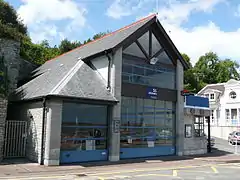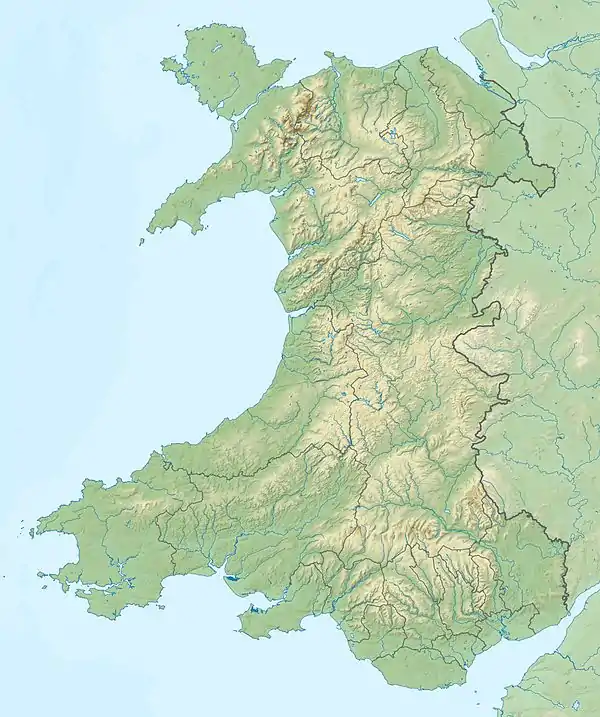Penarth Lifeboat Station
Penarth Lifeboat Station is located in Penarth, Vale of Glamorgan, Wales and originally opened in 1861.[1]
| Penarth Lifeboat Station | |
|---|---|
 Penarth Lifeboat Station | |
 Penarth, Vale of Glamorgan | |
| General information | |
| Type | RNLI Lifeboat Station |
| Location | The Esplanade, Penarth, Vale of Glamorgan, UK |
| Country | Wales, UK |
| Coordinates | 51°25′57″N 3°10′08″W |
| Opened | 1861 |
| Owner | Royal National Lifeboat Institution |
The station was closed in 1905 with services transferred to other local stations, until 1980 when the station reopened on Penarth seafront with an inshore lifeboat. The station currently operates an Atlantic 85-class lifeboat and a D-class (IB1) lifeboat.
History
The Bristol Channel has always been a hazardous stretch of water because of the extreme tidal range. There are very strong currents or rips close inshore, with speeds that exceed 7 knots (13 km/h), for several hours at each tide. The rise and fall of the tides at Penarth are the second highest recorded anywhere in the world [2] The original 1861 oar-powered lifeboat was housed in a shed built near to where Penarth Yacht Club now stands at the southern end of Penarth beach and controlled by staff located at the Coastguard cottages and Trinity House lookout tower on Tower Hill near Marine Parade.
The manually powered (rowing) or "pulling boats" were 30 feet in length and were powered by 12 oars. They had cork in their hull and shaped air-cases fore and aft.[3] The boats were self-righting and their double-ended designs could operate a rudder from either end, so there was no need to turn.
In 1883 when the Yacht Club and the raised concrete esplanade were constructed along Penarth seafront an all-weather lifeboat was relocated to a yard and temporary slipway near the Taff Vale Railway’s Marine Hotel on the Dock Beach where it remained until 1905.
The Penarth lifeboat was withdrawn from service in 1905 and all services transferred to the new Barry Dock Lifeboat Station and the station at Weston-super-mare. Penarth would have no lifeboat service for the next 75 years until a new station opened in 1980.
With the regular daily hovercraft service between Penarth to Weston-super-mare, coupled with an increase in leisure boating generated by a new water skiing club, in 1980 it was decided to re-establish lifeboat services at Penarth with the provision of an inflatable inshore lifeboat. The new boat was located at the original site next to Penarth Yacht Club, housed in an unused storehouse and launched down the yacht club’s jetty.
The current boathouse was built in 1995 to house a B class lifeboat. Also provided were a Talus MB-4H[4] launching tractor, a workshop, an RNLI souvenir shop, a fuel store and improved crew facilities. The following year an Atlantic 21 class lifeboat arrived for a temporary duty at the station. That boat was replaced four months later by the Atlantic 75-class Spirit of Penarth (B-725) and the D-class Severn Rescuer (D-534). The D-class lifeboat is launched using a TC45 tractor and carriage.
In 2010 Spirit of Penarth was withdrawn from service and replaced with an Atlantic 85-class Maureen Lilian (B-839)
Some historic rescues by the Penarth lifeboat
| Date of incident | Vessel in distress | Penarth Lifeboat | Details |
| 18 November 1864 | Far West | George Gay | The Penarth lifeboat was towed by the paddle tug Marquis to the English and Welsh grounds near the mouth of the River Usk where the full-rigger Far West of Newport was aground with 22 crewmen, having lost her anchors, hawsers and windlass off Lundy. The Penarth lifeboatmen were put aboard, her anchors recovered and she was eventually refloated before being towed to Bristol for repairs. |
| 17 November 1867 | Marie | George Gay | The brig Marie from Grieffswald, Prussia lost her anchor and cables and was driven up the Bristol Channel and into shallow waters by high winds after rescue attempts by three tugs and two pilot skiffs failed. After ten hours of rowing the Penarth lifeboat managed to manoeuvre under her lee and rescued all 11 sailors. The lifeboat crew were as exhausted as the rescued seamen and suffering from exposure. |
| 1 November 1872 | Jernbyrd | George Gay II | The Norwegian barque Jernbyrd and the Magna Carta from Halifax, Nova Scotia collided during a heavy gale in Penarth Roads. The Canadian ship freed herself but the Norwegian vessel was holed below the water line and the Penarth lifeboat launched to assist. The Norwegian captain asked the lifeboat to stand by while his crew attempted repairs; they stayed alongside all night until dawn when the ship was towed to Cardiff for repairs. |
| 6 December 1872 | Eleanor | George Gay II | During a bad storm the brig Wallace rolled over and sank with all hands and a Nova Scotian barque also sank with its full crew. The Penarth lifeboat launched to assist the Eleanor of Quebec that had gone aground on Cardiff Sands. They rescued five crew members but the ship’s mate refused to leave his vessel. The following day the lifeboat rowed out twice with crew members who re-boarded and were able to re-float her and sail to Cardiff. |
| 7 March 1877 | Crocodile | Joseph Denman | The Penarth lifeboat launched to assist the brig Crocodile from Dartmouth that had gone aground on Cardiff Sands in high winds. The brig was re-floated on the flood tide and continued its journey to Cardiff docks. |
| 14 October 1881 | Febo | Joseph Denman | The barque Febo from Genoa was driven up the Bristol Channel by a stiff gale until she was off Penarth Roads in poor shape, her fore and main masts broken at deck level and her anchors lost. The Penarth lifeboat launched and put several lifeboatmen on board to jury-rig temporary sails. The vessel was taken in tow by a tugboat and the lifeboat took 14 crew members to the shore. |
| 27 January 1884 | Juan de la Vega | Joseph Denman | The Spanish brigantine was bound for Cardiff with a heavy cargo of pit-props and found itself in difficulty off Lavernock Head. The lifeboatmen from Penarth repaired the rigging and commenced pumping her out while she was towed to Cardiff dock by a tug. |
Fleet
All Weather Boats
| Dates in service | Class | Name |
|---|---|---|
| 1861–1870 | Greathead-class | George Gay |
| 1870–1875 | Greathead-class | George Gay II |
| 1875–1890 | Greathead-class | Joseph Denman |
| 1890–1905 | Greathead-class | Unknown |
D-class
| Dates in service | Class | Op. No. | Name |
|---|---|---|---|
| 1981–1989 | D-class (Zodiac III) | D-279 | unnamed |
| 1989–1998 | D-class (EA16) | D-384 | John Cresswell |
| 1998–2008 | D-class (EA16) | D-534 | Severn Rescuer |
| 2008–2018 | D-class (IB1) | D-692 | Connie Dains |
| 2018- | D-class (IB1) | D-822 | Spirit of Penarth II |
B-class
| Dates in service | Class | Op. No. | Name |
|---|---|---|---|
| 1996–1996 | Atlantic 21-class | B-515 | V E Webber |
| 1996–2010 | Atlantic 75-class | B-725 | Spirit of Penarth |
| 2010–present | Atlantic 85-class | B-839 | Maureen Lilian |
Station Honours
Framed Letter of Thanks - 2002
- A framed Letter of Thanks was presented to Helmsman Simeon Rabaiotti, for rescuing a man cut off by the tide on 25 May. The ILB veered down through rocks in rough seas and in a heavy three metre swell; the anchor warp had to be cut to leave the scene.
Thanks of the Institute inscribed on Vellum - 2012
- Thanks of the Institute inscribed on Vellum was presented to Jason Dunlop and Aran Pitter in recognition of their leadership, seamanship skills and actions during a rescue of a yacht in danger close to Lavernock point.
References
- First opening
- Tide information
- "'Report of the committee appointed to examine the lifeboats submitted to compete for the premium offered by his Grace the Duke of Northumberland'". River & Rowing Museum. Retrieved 15 July 2009.
- "Talus MB-4H Tractor". Details of the MB-4H production. Clayton Engineering Ltd. Retrieved 26 March 2014.